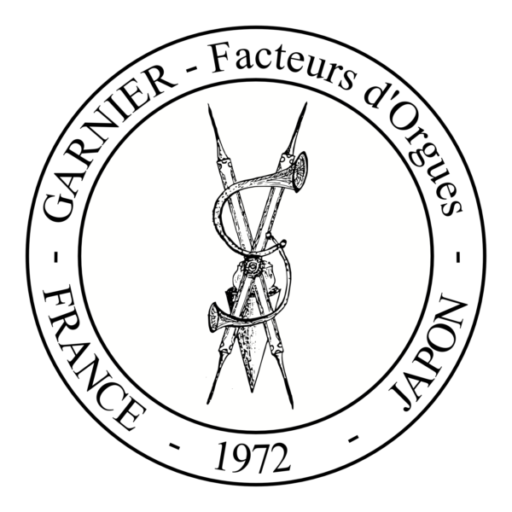Garnier Marc
ガルニエ マルク
GARNIER ORGANUM 有限会社創設者
オルガン製作において52年の豊富な経験を誇り、当社で最も経験豊富なオルガン製作者です。1970年代には、クラスボルトやハラルフォーゲルと並び、古楽オルガン運動のパイオニアとして古楽再発見のために尽力しました。
経歴:
1957-1960年 フランス、ベルフォール高校にて電気技術を学び、教会で毎週の礼拝奏楽を行う中でオルガンへの情熱を深めました。
1965-1969年 ストラスブールのカート・シュヴェンケデルにてオルガン製作の見習いを始め、基礎的な訓練を受けた後、新しいオルガンの製作方法や修復技術を学びました。技術を修得後は、メカニックデザイナーとしてコンソール、トラッカー、その他楽器部品の設計を担当。
1970-1972年 ドイツ、ルドルフ・フォン・ベッケラートにて研修を終え、北ドイツの素晴らしいオルガンと出会う。その後、チェンバロビルダーのレイナー・シュッツェと共に勤務し、技術を磨きました。1972年にフランスに戻り、自らの工房を開設。
1972-1981年 フランスの工房で作られた楽器は、ドイツや周辺地域のバロック様式を踏襲し、伝統的な製作方法を採用しました。1976年に完成した最初のオルガン(ストラスブールの聖ポール教会)は、スプリングチェスト、ショートオクターブ、金属パイプにハンマー成形を使用し、ミーントーン調律を採用するなど、革新的な特徴を持っていました。その他の主な作品には、メッツ大聖堂のルネサンス様式オルガン(1981年)や、エスケルベックの分割鍵盤を備えたオルガン(1982年)などがあります。
1982-2017年 日本でのオルガン製作が始まり、神戸松蔭女子学院大学に設置されたオルガン(1983年)を皮切りに、日本国内で多数のオルガンを手掛けました。東京の聖路加国際病院、東京芸術劇場、東京基督教大学など、多くの施設にオルガンを納品しました。また、現代的な技術を取り入れた複雑なオルガンも製作し、その独自性を追求しました。
1985年 ストラスブールにフランス国立オルガン製作・パイプ製作学校を設立。現在もフランス国立教育委員会により運営されています。
オルガンの音楽性に対する深い理解と技術を活かし、最適な整音を行うための独自の道具や方法を開発しました。パイプと風箱の自動3D設計を支援するソフトウェアを開発し、これらの技術は現在も使用されています。
対応可能言語:フランス語、ドイツ語、アルザス語、英語
Marc is the highest experienced organ builder of our company and a pioneer in the early North German organ movement for early music rediscovery, alongside Klass Bolt and Haral Vogel, in the70s. (1957-1960): Marc holds an Electrical and Technologist Diploma from the High School of Belfort, France. It is while playing at church for the weekly service that he discovers his passion for organs.
(1965-1969): Marc does his apprenticeship with Curt Schwenkedel in Strasbourg. He receives basic training there and learns organ building methods used in that time for new organs as well as restoration work. He rapidly gains skills and is appointed mechanic designer in the technical area where he is in charge of the console, trackers, and other technical parts of the instruments.
(1970-1972): He finishes his training in Germany with Rudolf von Beckerath where he has the opportunity to discover instruments from Germany and more specifically the Northern German area. He then extends his training with the harpsichord builder Rainer Schutze. In 1972, once back in France, he opens his own workshop.
(1972-1981): From the very beginning the instruments built in his workshop have displayed a historical orientation leaning towards the Northern European baroque style. Marc revives the historical German spring-chest (inspired by the model found in the Schnitger Organ of Langwarden), which he used in almost all instruments. His first church organ, in Strasbourg’s St-Paul Church (1976 – 2 kb/33stps) demonstrates the use of the technique with a spring-chest, a short octave, pipe work of 97% lead hammered metal, and cuneiform bellows. It was the first new organ of the 20th century to use mesotonic tuning, with two optional supplementary notes per octav.
Other important instruments built at that time are: a Renaissance-style organ built inside a 1537 case (1981 – 2kb/10stps) at the Metz Cathedral, an organ with double semitone and sharp keys (1982 – 2 kb/25stps) in Esquelbecq and a Northern style German organ (1983 – 2kb/24stps) at the protestant church in Belfort.
(1982-2017): The first French classical organ that Marc built was his first commissioned instrument in Japan. It was commissiond by the Shoin University (1983 – 4kb/33stps), in Kobe.
He continues to build in Japan and adapts his craftsmanship to meet the clients’ needs. He builds the organ for Tokyo’s St-Luke’s Hospital (1988 – 3kb/31stps) and continues with the highly innovative instrument for the Tokyo Metropolitan Art Space (1991 – 8kb/126stps). Built on three revolving decks, with historical and contemporary cases, it is in fact three independent instruments in the same organ chests, each with different pitch and tuning: a Dutch Renaissance organ (26 stps) and a German Baroque organ (37 stps), both played from the three-manual historical console, and a classical French organ with a Romantic extension (63 stops), played from the five-manual contemporary console. Despite the complexity, tracker action and spring-driven windchests are used. Subsequently, simplified interpretation of the same style may be found at the Tokyo Christian Institute (1995 – 3kb/31stps), Morioka Civil Hall (1998 – 3kb/34stps) and Tokyo Geidai Daigaku (1999 – 5kb/76stps).
Marc GARNIER has also built organs with more contemporary cases in Germany (Kircheim Teck, Tübingen and Waldshut). Since the beginning, back in 1972, Marc has always been looking to enhance the way he builds organs.z Along with his wife Elisabeth (a pianist, organist and harpsichordist), he constantly works on improving his understanding of the musical aspect of the instruments and looks at what a good voicing process requires in order to be optimized.
He is the first organ builder in the world who reintroduced voicing the instruments completely on customer site, developing his own tools and methods to do so and therefor optimizing the musicality of the instrument.
Marc developed his own software programs to help analyze and scale the pipes, using computerised harmonic curves generating automatic 3D designs of pipes and wind-chests. Those tools are still in use today and are part of the success of his organs.
In 1979, alongside his organ building activity, Marc becomes one of the founders and the president of the GPFO (French Organ builder Association) in Eschau, France. In 1985, he creates the French National Organ Builder and Pipes Maker School in Strasbourg. Today, this organ building school is managed by the French National School Board.
Marc speaks French, German and Alsatian (a dialect of German) fluently. He also has an intermediate level of English.
